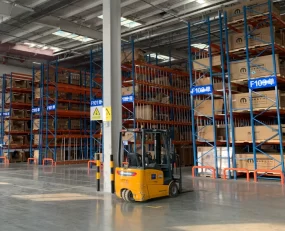
Ti has formulated its warehouse cost index, which looks to track overall warehousing costs in North America, Europe, and North-East Asia. The index utilises inputs from warehousing rent, labour, and energy costs to determine the current state of overall warehousing costs, as well as estimate the future direction of costs.
Warehouse Cost Index – Major Regions
Ti’s Warehousing Cost Index details that warehouse costs have been rising steadily since Q1 2022. However, y-o-y cost growth has slowed substantially into Q4 2023, particularly in Western economies.
Both Europe and North-East Asia saw very marginal q-o-q cost growth in Q4 2023, of 0.7% and 0.3%, respectively. North America saw its costs decrease by 3.8% q-o-q, driven primarily by rent decreases in Canada.
Looking forward, warehousing costs are likely to continue growing and remain elevated in comparison with historic norms, more so in Western economies than in North-East Asia.
We would therefore expect costs in both North America and Europe to continue growing over the next year, although at a slower pace than in previous years. From mid-to-late 2024 and into 2025 however, we’d expect costs to push upward at a quicker pace once more, as reduced warehouse completions push down on vacancy figures and demand recovers.
We would expect costs in North-East Asia to remain mostly flat or decrease depending on the market, as an abundance of supply leaves little room for cost and rent growth.
Vacancy rates remain significantly higher in Q4 2023 than Q4 2022 across all three major regions due to an influx of new supply and moderating demand. Demand has meanwhile been cooling substantially throughout 2023. Into 2024, the warehouse market is expected to follow the same path as the global economy, and will see tentative demand recovery, more so in the latter half of the year.
Looking forward in the medium-term more stock will likely hit the global market. Moving into mid/late 2024 and beyond we would expect the market to see lower vacancy rates and supply levels once more as developers pull back on new projects and demand recovers.
Download Ti’s latest Warehouse Tracker whitepaper here.
Supply chain strategists can use GSCi – Ti’s online data platform – to identify opportunities for growth, support strategic decisions, help them stay abreast of industry trends and development, as well as understand future impacts on the industry.
Visit GSCI subscription to sign up today or contact Michael Clover for a free demonstration: [email protected] | +44 (0) 1666 519907